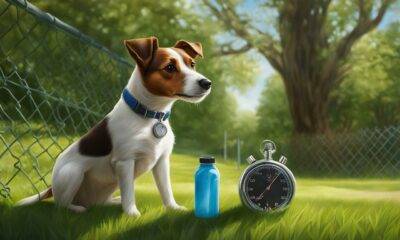dogs
Mastering How to Train a Pitbull Puppy Not to Bite: A Guide
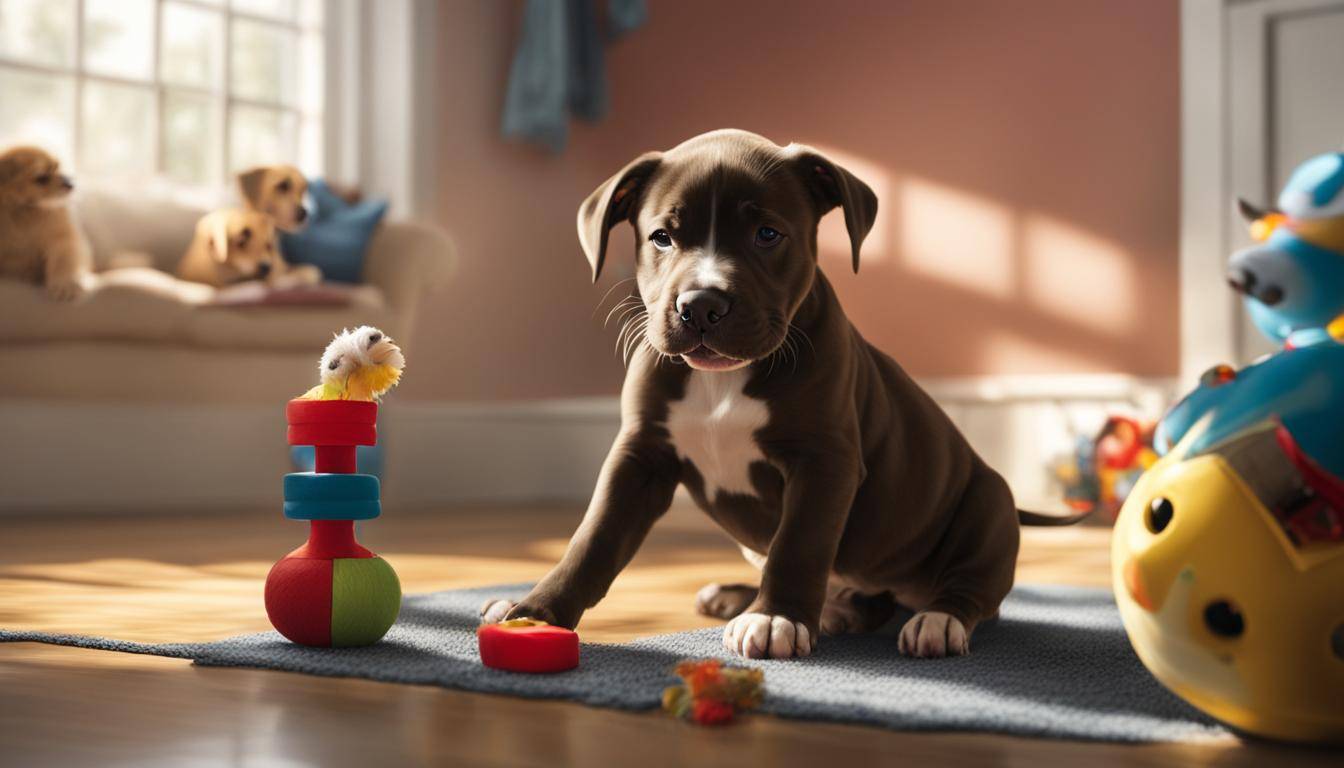
Welcome to our comprehensive guide on how to train a pitbull puppy not to bite. As a responsible pitbull owner, it’s crucial to promote positive behavior and ensure the safety of your puppy and those around them. In this guide, we will explore effective methods and strategies to prevent biting and create a harmonious environment for your furry friend.
Key Takeaways:
- Training a pitbull puppy not to bite is important for their safety and the well-being of others.
- Understanding the various causes of aggression in pitbull puppies is essential in managing and addressing the issue effectively.
- Managing a pitbull puppy with behavior challenges involves implementing effective management strategies and addressing their emotional state.
- Getting to know your pitbull puppy and their triggers is crucial in preventing biting incidents.
- Training techniques for pitbull puppies should focus on positive reinforcement and relationship-based methods.
Understanding Aggression in Dogs and Pitbull Puppies
Aggression in dogs, including pitbull puppies, can be a concerning behavior that needs to be addressed. In order to effectively manage and prevent aggression, it is important to understand its root causes and warning signs.
One key aspect to consider is bite inhibition in pitbull puppies. Bite inhibition refers to a dog’s ability to control the force of their bite. It is an important skill for all dogs to learn, as it helps prevent potential injuries when interacting with humans or other animals. By teaching bite inhibition to pitbull puppies during their early development stages, we can significantly reduce the risk of serious harm.
Pitbull puppy behavior training should focus on promoting positive behaviors while discouraging aggressive tendencies. This can be achieved through proper socialization, consistent training techniques, and the use of positive reinforcement. By identifying triggers and addressing underlying emotional states that may lead to aggression, we can effectively manage and modify the behavior of pitbull puppies.
“Understanding the triggers and emotional states that lead to aggressive behavior can help in managing and addressing the issue effectively.”
Warning Signs of Aggression:
- • Dilated pupils
- • Raised hackles
- • Ears going back
- • Lip licking
Recognizing these warning signs can help owners intervene before a potential aggressive episode occurs. It is important to note that punishing a dog for growling or showing these signs can be counterproductive, as it may suppress their ability to communicate their discomfort. Instead, a proactive approach that focuses on positive reinforcement and addressing the underlying triggers is more effective in managing aggression in pitbull puppies.
| Common Causes of Aggression in Pitbull Puppies | Effective Strategies |
|---|---|
| Fear or anxiety | Socialization and desensitization exercises |
| Resource guarding | Positive reinforcement training, gradual desensitization |
| Pain or discomfort | Consult a veterinarian for medical evaluation and treatment |
| Undesired territorial behavior | Professional guidance, behavior modification techniques |
Understanding aggression in dogs, particularly pitbull puppies, is crucial for their well-being and the safety of those around them. By recognizing the warning signs, promoting bite inhibition, and implementing effective training techniques, we can create a harmonious environment and help prevent potential aggressive incidents. Remember, seeking professional guidance from a qualified dog trainer or animal behavior consultant can provide valuable support in addressing aggression and ensuring a positive outcome for both you and your pitbull puppy.
Managing a Pitbull Puppy with Behavior Challenges
Managing a pitbull puppy with behavior challenges is crucial to prevent them from practicing undesirable behaviors and ensure the safety of those around them. Here are some effective methods for training a pitbull puppy and preventing biting:
- Clear communication: Use signs and signals to communicate training protocols to anyone who interacts with your puppy. This will help set expectations and create a consistent environment for training.
- Physical and visual barriers: Utilize doors, baby gates, and other barriers to restrict access to certain areas. This can prevent your puppy from engaging in undesirable behaviors and keep them in a controlled environment.
- Crate training: Teach your puppy to use a crate as their safe place. A crate can act as a management tool to prevent biting incidents and provide a calm space for your puppy to retreat to.
- Basket muzzles: If your puppy’s biting behavior is a safety concern, consider using a basket muzzle during training and socialization activities. This will prevent them from biting while allowing them to breathe and pant comfortably.
- High-value treats: Use high-value treats to reward your puppy for good behavior and redirect their attention away from biting. This positive reinforcement technique can help reinforce desired behaviors and discourage biting.
- Nutraceuticals: Consult with your veterinarian about the use of nutraceuticals, such as calming supplements or pheromone diffusers, to manage your puppy’s emotional state and promote balanced behavior.
Table: Comparison of Training Methods
| Training Method | Pros | Cons |
|---|---|---|
| Positive reinforcement | Encourages desired behaviors, strengthens the bond between owner and puppy | Requires consistency and patience, may take time for results |
| Physical punishment | Can provide immediate response, easy to implement | May cause fear or aggression in the puppy, damages trust and may worsen the behavior |
| Ignoring unwanted behavior | Teaches the puppy that biting does not result in attention or rewards | May require time and repetition, ineffective for some puppies |
| Redirecting biting to appropriate toys | Teaches the puppy what is acceptable to bite, helps satisfy their natural chewing instinct | Requires consistent redirecting, may not work for all puppies |
Remember, managing behavior challenges in a pitbull puppy requires patience, consistency, and a holistic approach. It’s important to understand your puppy’s needs, provide a safe and structured environment, and use positive reinforcement techniques. If you’re facing difficulty, don’t hesitate to seek professional help from a qualified dog trainer or behaviorist who specializes in working with pitbulls. With dedication and the right training methods, you can help your pitbull puppy overcome behavior challenges and thrive in a loving home.
Getting to Know Your Pitbull Puppy
When it comes to teaching pitbull puppies not to bite, it is crucial to get to know your furry friend on a deeper level. Understanding your puppy’s triggers and body language can help you avoid situations that may lead to biting. Dogs communicate through their body language, so pay close attention to their signals.
If your pitbull puppy starts growling, showing teeth, or stiffening their body, it may be a sign that they are uncomfortable or fearful. Reacting promptly and appropriately can prevent a potential bite. Building a trusting relationship with your puppy through positive reinforcement and reward-based training methods is essential.
Remember, getting to know your pitbull puppy is a gradual process. Be patient and observe their behaviors closely. By taking the time to understand your puppy’s needs and preferences, you can create a safe and supportive environment, reducing the chances of biting incidents.
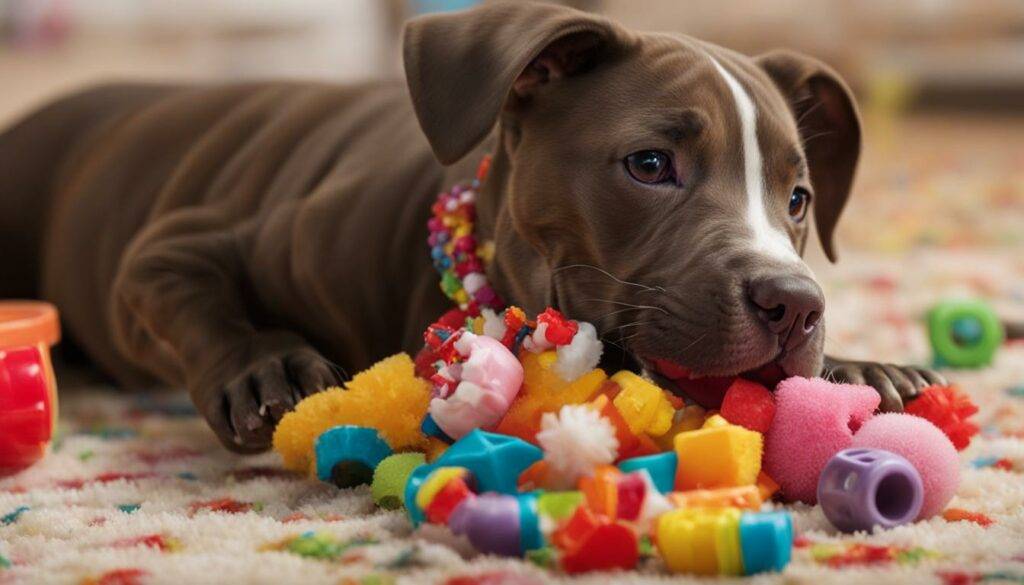
Signs of Discomfort in Pitbull Puppies
- Growling
- Showing teeth
- Stiffened body
- Avoiding eye contact
- Whale eye (wide-eyed with the whites of the eyes visible)
- Tail tucked between the legs
“Understanding your pitbull puppy’s body language is key to preventing biting incidents.”
Tips for Building Trust
- Use positive reinforcement techniques such as treats and praise to reward good behavior.
- Be consistent in your training methods and expectations.
- Avoid punishment or harsh corrections, as it can damage the trust between you and your puppy.
- Give your puppy plenty of socialization experiences with different people, animals, and environments.
| Training Technique | Description |
|---|---|
| Redirecting | If your puppy starts biting, redirect their attention to a chew toy or bone. |
| Timeouts | If the biting continues, calmly remove yourself from the situation and give your puppy a short timeout in a separate area. |
| Consistency | Consistently reinforce desired behaviors and avoid inconsistent or mixed signals. |
Training Techniques for Pitbull Puppies
When it comes to training pitbull puppies, effective methods are essential for creating a well-behaved and obedient companion. Here are some tips to help you train your pitbull puppy to not bite:
Consistency and Positive Reinforcement
- Consistency is key when training a pitbull puppy. Set clear expectations and establish a routine to reinforce desirable behaviors.
- Use positive reinforcement techniques such as rewards and praise when the puppy exhibits good behavior. This helps to reinforce the desired actions and encourages them to repeat them.
- Avoid punishment or physical force as it can lead to fear and aggression in the puppy.
Socialization and Exposure
- Socialization is crucial for pitbull puppies to learn how to interact with people, animals, and different environments.
- Expose your puppy to various situations and stimuli in a controlled and positive manner.
- Gradually introduce new experiences and environments to help them become well-rounded and confident.
Professional Guidance
- If you’re facing challenges in training your pitbull puppy or if they continue to exhibit biting behavior, seeking professional help can make a significant difference.
- A qualified dog trainer or certified behavior consultant can provide personalized guidance and develop a training plan tailored to your puppy’s specific needs.
- They can help you understand the underlying causes of the biting behavior and guide you through effective techniques to address it.
Remember, training a pitbull puppy takes time, patience, and consistent effort. By using positive reinforcement, socializing your puppy, and seeking professional guidance when needed, you can help them develop into a well-behaved and non-aggressive dog.
| Training Technique | Description |
|---|---|
| Clicker Training | Using a clicker to mark desired behaviors and rewarding the puppy with treats or praise. |
| Redirecting Biting | When the puppy tries to bite, redirect their attention to a chew toy or appropriate item. |
| Using Bite Inhibition | Gradually teaching the puppy to control the force of their bite through gentle feedback and discouraging hard biting. |
| Basic Obedience Training | Teaching essential commands like sit, stay, and come, which provide structure and help prevent unwanted behaviors. |
Professional Help for Pitbull Puppy Biting
When it comes to addressing persistent biting behavior in your pitbull puppy, seeking professional help can be beneficial. Professional trainers or certified animal behavior consultants have the knowledge and expertise to assess the situation and provide tailored guidance to resolve the issue.
A qualified professional will first evaluate your puppy’s behavior to identify any underlying causes that may be contributing to the biting. They will consider factors such as fear, anxiety, or inadequate socialization. Based on their assessment, they will then develop a behavior modification plan.
This plan will involve structured training sessions and techniques that focus on redirecting your puppy’s biting behavior and promoting alternative, more appropriate actions. Professionals can offer valuable insights and strategies to help you effectively teach your pitbull puppy not to bite.
Benefits of Professional Help:
- Expert assessment and understanding of your puppy’s behavior
- Personalized behavior modification plan tailored to your puppy’s needs
- Effective techniques and strategies to redirect biting behavior
- Guidance on creating a positive and safe environment for your puppy
- Access to ongoing support and advice throughout the training process
Remember, each puppy is unique, and what works for one may not work for another. Seeking professional help ensures that you receive guidance that is specific to your pitbull puppy’s individual needs, increasing the likelihood of successful behavior modification.
Safety Measures for Pitbull Puppies
Ensuring the safety of your pitbull puppy and those around them is our top priority. While training is essential, implementing safety measures can help prevent potential biting incidents and promote responsible ownership.
Using a Harness, Muzzle, or Head Halter
One effective safety measure is using a harness, muzzle, or head halter when taking your pitbull puppy outside. These tools provide additional control and prevent the puppy from biting or injuring others. It is essential to choose the right equipment that fits well and allows the puppy to breathe and pant comfortably.
Keeping Your Puppy on a Leash
Until your pitbull puppy learns not to bite, it is important to keep them on a leash when outside. This allows you to have better control over their movements and prevents them from approaching strangers or engaging in aggressive behavior. Always supervise your puppy closely, and never leave them unattended while on a leash.
Supervision and Controlled Environment
Pitbull puppies should always be supervised, especially when interacting with children, other pets, or unfamiliar individuals. Additionally, creating a controlled environment by using baby gates or doors can help prevent biting incidents. Designate specific areas where the puppy can play and relax under your supervision.
| Safety Measure | Description |
|---|---|
| Using a Harness, Muzzle, or Head Halter | These tools provide additional control and prevent biting or injuring others. Choose the appropriate equipment that fits well and allows the puppy to breathe comfortably. |
| Keeping Your Puppy on a Leash | Prevent the puppy from approaching strangers or engaging in aggressive behavior by keeping them on a leash when outside. Always supervise closely. |
| Supervision and Controlled Environment | Supervise the puppy when interacting with others and create a controlled environment using baby gates or doors to prevent biting incidents. |
By implementing these safety measures, you can reduce the risk of biting incidents and create a safer environment for your pitbull puppy and those around them. Remember, prevention is key, and responsible ownership plays a crucial role in the overall well-being of your furry friend.
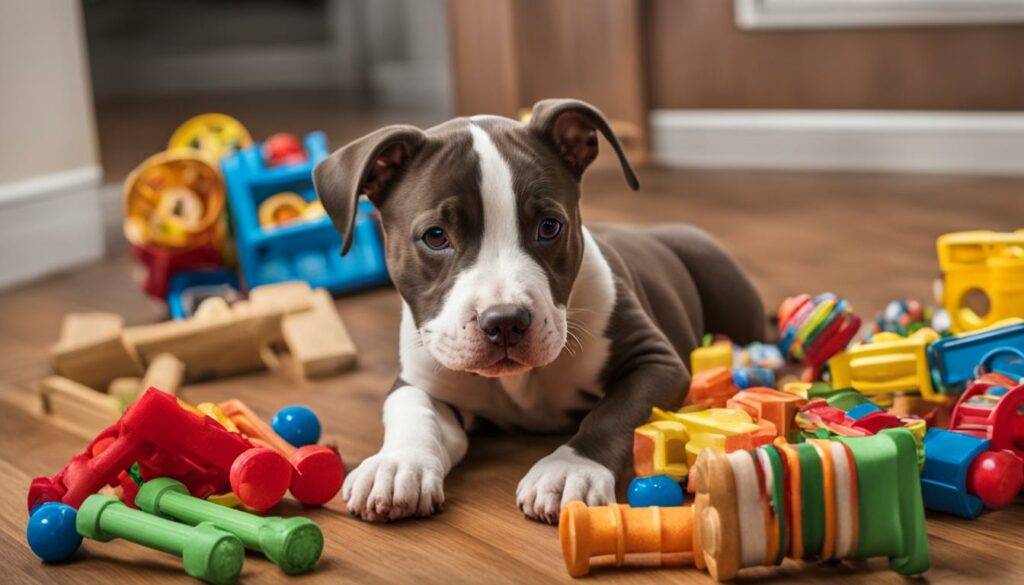
Socialization: Building a Well-Adjusted Pitbull Puppy
When it comes to training pitbull puppies, one crucial aspect often overlooked is socialization. Socialization plays a vital role in shaping a pitbull puppy’s behavior and temperament, helping them become well-adjusted and confident adult dogs. It is an ongoing process that requires consistent effort and dedication from us as responsible pet owners.
During the socialization process, we expose our pitbull puppies to various environments, people, animals, and experiences in a controlled and positive manner. This exposure helps them develop positive associations and learn how to navigate different situations without fear or aggression. By introducing them to new stimuli, we can reduce the likelihood of fearful or aggressive responses in the future.
It’s important to start socializing our pitbull puppies at a young age, ideally between 3 and 14 weeks old, as this is when they are most receptive to new experiences. However, older puppies and adult dogs can still benefit from socialization efforts. The key is to provide gradual, positive exposure without overwhelming them.
Benefits of Socialization:
- Builds confidence and reduces fearfulness
- Promotes positive interactions with people and animals
- Prevents aggression and reactive behavior
- Enhances adaptability to different environments
“Socialization helps pitbull puppies develop necessary life skills and allows them to become well-rounded members of our families,” says Dr. Emily Johnson, a certified animal behavior consultant. “It’s crucial to expose them to a wide range of experiences to foster resilience and prevent behavior problems.”
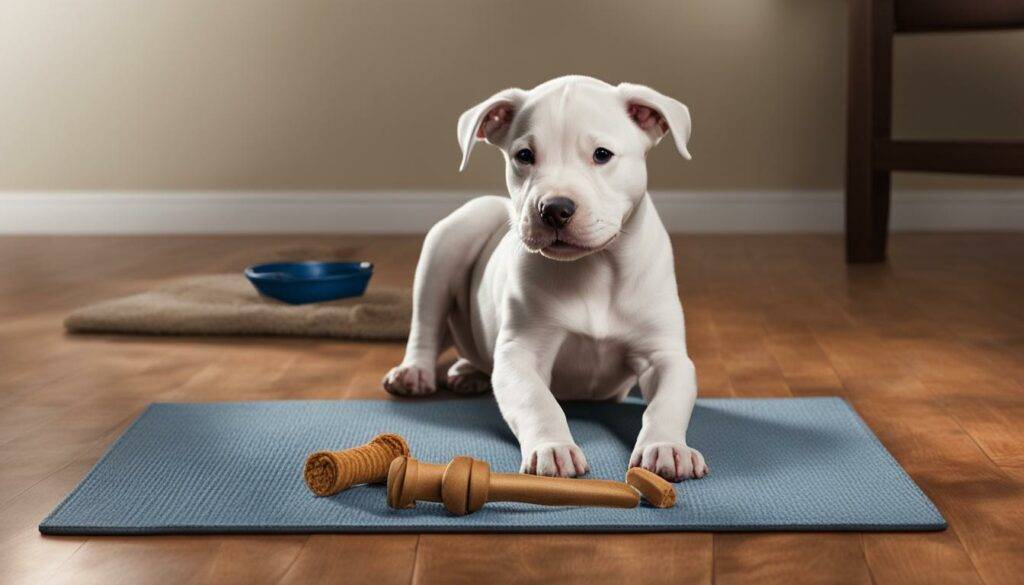
Tips for Effective Socialization:
- Introduce your pitbull puppy to safe and controlled environments with different sights, sounds, textures, and surfaces.
- Gradually expose them to various people of different ages, appearances, and behaviors. Encourage positive interactions and reward calm and friendly behavior.
- Arrange playdates with well-behaved and vaccinated dogs to encourage appropriate social interactions and play behavior.
- Enroll your pitbull puppy in puppy socialization classes where they can interact with other puppies and learn valuable social skills under the guidance of a professional trainer.
- Expose them to common urban sights and sounds, such as traffic, bicycles, and loud noises, to build their confidence in diverse environments.
Remember, socialization is an ongoing process that should continue throughout your pitbull puppy’s life. Regularly exposing them to new experiences and reinforcing positive behaviors will help them become confident, well-adjusted, and happy companions.
The Role of Veterinary Care in Biting Prevention
When it comes to preventing biting in pitbull puppies, veterinary care plays a crucial role. Before addressing any behavioral issues, it is important to rule out any underlying medical causes that may contribute to aggression. A thorough examination by a veterinarian can help identify and address any physical discomfort or health issues that may be influencing your puppy’s behavior.
Collaborating with a veterinarian throughout the training process ensures a holistic approach to biting prevention. They can provide guidance on nutrition, exercise, and overall health to ensure your puppy is in optimal condition. Additionally, a veterinarian can assess your puppy’s behavior and offer recommendations specific to their individual needs.
Remember, prevention is key when it comes to biting in pitbull puppies. Regular check-ups, vaccinations, and preventive treatments are essential to keep your puppy healthy and reduce any potential sources of aggression. By working closely with your veterinarian, you can take proactive measures to create a safe and happy environment for your pitbull puppy.

Importance of Regular Veterinary Check-ups for Biting Prevention
Regular veterinary check-ups are crucial for biting prevention in pitbull puppies. These check-ups allow veterinarians to detect any underlying health issues that may contribute to aggressive behavior. By addressing these issues early on, you can help prevent biting incidents and ensure the overall well-being of your puppy.
| Advantages of Regular Veterinary Check-ups | How They Help Prevent Biting |
|---|---|
| Early detection of medical conditions | Addressing physical discomfort that may cause aggression |
| Evaluation of behavior and temperament | Identifying triggers and providing behavior modification techniques |
| Nutritional guidance | Ensuring a balanced diet to support overall health and well-being |
| Vaccinations and preventive treatments | Reducing the risk of diseases that may cause behavioral changes |
Regular veterinary check-ups are an essential part of responsible pet ownership. By prioritizing your puppy’s health and well-being, you can take proactive measures to prevent biting and create a harmonious bond with your pitbull puppy.
The Importance of Building Trust and Patience
Building trust and patience with your pitbull puppy is crucial in effectively training them not to bite. Teaching a puppy to control their biting instinct requires consistency, positive reinforcement, and understanding. By following these methods, you can establish a strong bond with your puppy and create a safe environment for everyone involved.
Trust: Trust is the foundation of any successful relationship, including the one between you and your pitbull puppy. Trust is built through consistent positive interactions, gentle handling, and providing a sense of security. When your puppy feels safe and trusts you, they are more likely to respond positively to your training methods.
Patience: Training a pitbull puppy not to bite takes time and patience. Remember that puppies are learning and exploring the world around them, and biting is a natural behavior for them. Avoid using punishment or harsh methods, as these can damage your puppy’s trust and hinder their progress. Instead, focus on redirecting their biting behavior towards appropriate chew toys and rewarding them for choosing the right objects.
Fostering a Positive Learning Environment
Creating a positive learning environment is essential for teaching your pitbull puppy not to bite. Here are some effective methods to consider:
- Set clear boundaries and establish consistent rules for your puppy. Consistency is key in helping them understand what behaviors are acceptable.
- Use positive reinforcement techniques such as treats, praise, and play to reward your puppy for good behavior. This will motivate them to continue practicing the desired actions.
- Redirect your puppy’s biting behavior towards appropriate chew toys or interactive games. This helps them satisfy their urge to bite while teaching them what is appropriate to chew on.
| Effective Methods for Training a Pitbull Puppy |
|---|
| Consistency |
| Positive Reinforcement |
| Redirecting Biting Behavior |
By incorporating these methods into your training routine, you can effectively teach your pitbull puppy that biting is not acceptable behavior. Remember to be patient, consistent, and always prioritize building trust with your puppy. With time and dedication, you can guide them towards becoming a well-behaved and obedient companion.
Conclusion
To train a pitbull puppy not to bite, we need to commit to consistent effort, patience, and understanding. By implementing positive reinforcement techniques and managing the puppy’s environment, we can create a harmonious and safe living environment for our furry friends. Remember, pitbull puppy training is a lifelong process, but with dedication, our puppies can grow into well-behaved and balanced adult dogs.
Throughout the training journey, it is important to prioritize safety measures. Using a leash, harness, or muzzle can prevent potential biting incidents, ensuring the safety of both the puppy and those around them. Additionally, seeking professional help when needed can provide valuable guidance tailored to our puppy’s specific needs.
Training a pitbull puppy not to bite requires a holistic approach. While focusing on teaching them essential cues, we should also pay attention to their socialization, veterinary care, and the importance of building trust and patience. By incorporating these strategies into our training routine, we can create a loving and well-rounded companion who will bring joy to our lives for years to come.
FAQ
Why is it important to train a pitbull puppy not to bite?
Training a pitbull puppy not to bite is important for their safety and the well-being of others. It helps prevent potential accidents and promotes responsible ownership.
What are the warning signs of aggression in pitbull puppies?
Warning signs of aggression in pitbull puppies include dilated pupils, raised hackles, ears going back, and lip licking.
Should I punish my pitbull puppy for growling?
Punishing a dog for growling can be counterproductive as it suppresses their ability to communicate their discomfort. It is important to understand their triggers and emotional states to manage and address the issue effectively.
How can I manage a pitbull puppy with behavior challenges?
Effective management strategies include using physical and visual barriers, training the puppy to use a crate as their safe place, and utilizing tools like basket muzzles and high-value treats.
How can I understand my pitbull puppy’s triggers and avoid biting situations?
Observing your puppy’s body language closely and building a trusting relationship through positive reinforcement and reward-based training methods is key to understanding their triggers and avoiding biting situations.
What training techniques should I use for my pitbull puppy?
Training techniques for pitbull puppies should focus on positive reinforcement and gentle teaching. Consistency, patience, and seeking professional help if needed are important during the training process.
What should I do if my pitbull puppy continues to bite despite my efforts?
If your pitbull puppy continues to exhibit biting behavior, it may be beneficial to seek professional help from a qualified dog trainer or certified animal behavior consultant. They can assess the situation and design a behavior modification plan tailored to your puppy’s needs.
How can I ensure the safety of my pitbull puppy and others?
Implementing safety measures such as using a harness, muzzle, or head halter, keeping the puppy on a leash when outside, and closely supervising them can prevent biting incidents and promote responsible ownership.
Is socialization important for pitbull puppies?
Yes, socialization is a lifelong process for pitbull puppies. Exposing them to various environments, people, and animals in a controlled and positive manner helps them become comfortable and confident.
Why is veterinary care important in biting prevention?
Before addressing behavioral issues, it is essential to rule out any underlying medical causes that may contribute to aggression. A thorough examination by a veterinarian can help identify and address any physical discomfort or health issues that may influence the puppy’s behavior.
How can I build trust and patience with my pitbull puppy?
Building trust and patience with your pitbull puppy is essential for successful training. By offering rewards, maintaining a positive and patient attitude, and earning desired behaviors, you can foster a strong bond with your puppy.
Source Links
Dog Care and Maintenance
Understanding How Much to Train a German Shepherd: Costs & Tips
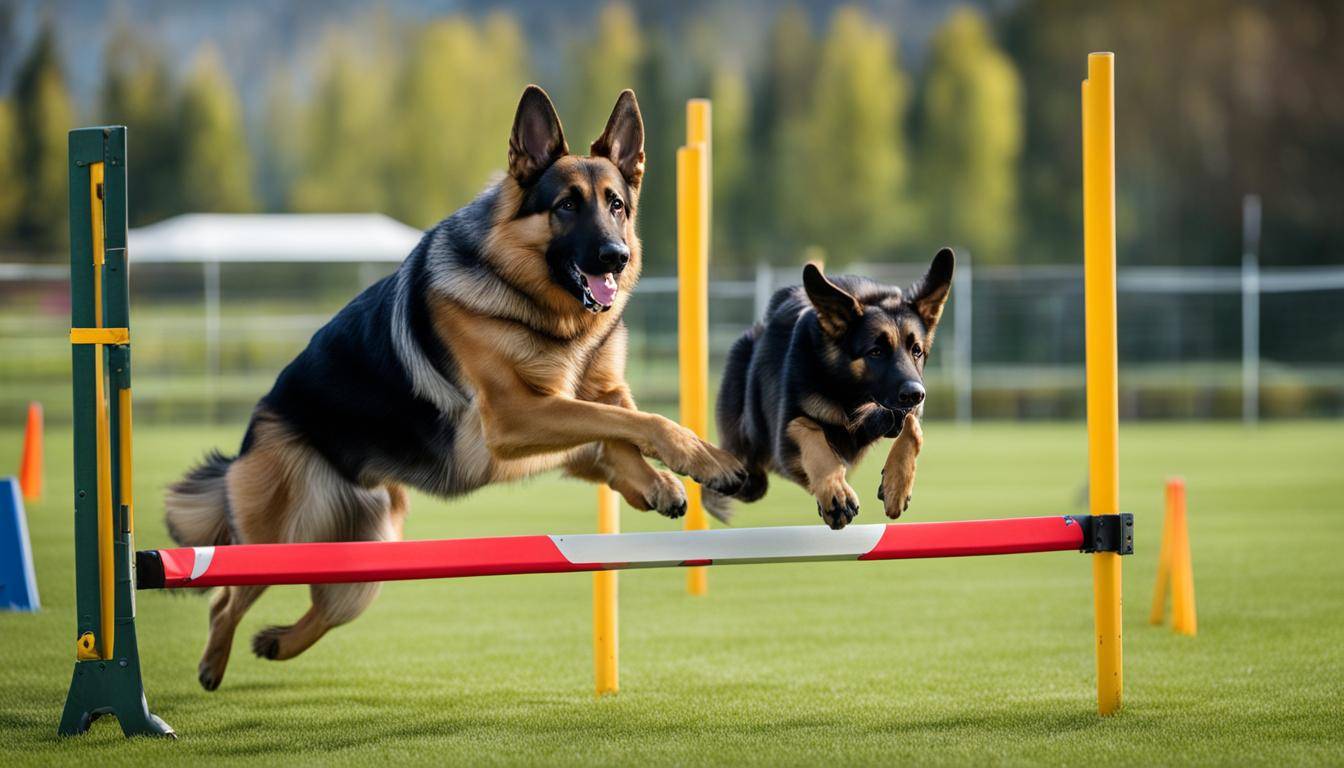
If you’ve been thinking about how much does it cost to train a German Shepherd, then you’re one of the few who understand the importance of obedience for this strong working breed. German Shepherds are intelligent, loyal, and versatile dogs, but they require proper training to reach their full potential. In this article, we will explore the costs associated with training a German Shepherd and provide you with some valuable tips to help you make an informed decision.
Key Takeaways:
- Training a German Shepherd can range from basic obedience classes to specialized service dog training.
- The average price for basic obedience classes is $30 to $80 per session, while dog obedience training schools can cost $250 to $700 per week.
- Factors that influence the cost of German Shepherd training include the quality of the trainer, one-to-one or group classes, and the location of the training school.
- Training your German Shepherd at home with online programs or instructional videos can be a cost-effective option.
- Consider ongoing expenses such as high-quality food, grooming, and continued training when budgeting for a German Shepherd.
Average Cost of German Shepherd Training
When considering training options for your German Shepherd, it’s important to understand the average cost of German Shepherd training. The cost can vary based on the type of training, the quality of the trainer, and the location of the training school.
For basic obedience classes, the average price ranges from $30 to $80 per class. Private training sessions, which offer more personalized attention, can cost between $45 to $120 per class. Group training classes are a more affordable option, typically ranging from $30 to $50 per session.
If you’re looking for a more intensive training program, dog boot camps provide comprehensive training for German Shepherds. These programs can range from $600 to $1,250 per week. Additionally, if you’re considering training your German Shepherd as a service dog, the cost can be around $120 per hour.
| Type of Training | Average Cost |
|---|---|
| Basic Obedience Classes | $30 – $80 per class |
| Private Training Sessions | $45 – $120 per class |
| Group Training Classes | $30 – $50 per session |
| Dog Boot Camp | $600 – $1,250 per week |
| Service Dog Training | Around $120 per hour |
Factors Affecting German Shepherd Training Costs
When it comes to training your German Shepherd, there are various factors that can affect the overall cost. Understanding these factors can help you make informed decisions about how to allocate your budget and ensure that you get the most value out of your training experience.
Quality of the Trainer and Education
The quality of the trainer and their level of education and experience can greatly impact the cost of German Shepherd training. Highly skilled and experienced trainers may charge higher fees for their services, but they can also deliver more effective and efficient training results. It’s important to consider the trainer’s qualifications and track record when selecting a training program for your German Shepherd.
One-to-One or Group Training
Another factor that can influence the cost of German Shepherd training is whether the training is conducted on a one-to-one basis or in a group setting. One-to-one training sessions typically involve more personalized attention and may therefore be more expensive. Group training classes, on the other hand, can be a more affordable option but may lack the individualized focus that some dogs require.
Expenses Involved in Running a Training School
The cost of operating a training school can also contribute to the overall training fees. Training schools incur various expenses such as rent, utilities, equipment, and overhead costs. These expenses are factored into the pricing structure of the training programs offered. When choosing a training school, it’s important to take into account the facilities and resources provided, as they can impact the overall quality of the training experience.
| Factor | Impact on Cost |
|---|---|
| Quality of the Trainer and Education | Higher fees for highly skilled and experienced trainers |
| One-to-One or Group Training | One-to-one training sessions are generally more expensive |
| Expenses Involved in Running a Training School | Overhead costs contribute to overall training fees |
By considering these factors, you can make an informed decision about the most suitable training program for your German Shepherd. While cost is an important consideration, it’s crucial to prioritize the quality of training to ensure the best results for your furry friend.

Different Types of German Shepherd Training
When it comes to training a German Shepherd, there are several different options to choose from. Understanding the various types of training available can help you make an informed decision based on your needs and preferences. Here are some of the most common types of German Shepherd training:
Obedience Training Classes
German Shepherd training classes are a popular choice for many owners. These classes are usually conducted in a group setting and focus on teaching basic obedience commands such as sit, stay, come, and heel. The cost of these classes can range from $30 to $50 per session, making them a more affordable option for many. Group classes also provide an opportunity for socialization with other dogs and their owners, which is important for a well-rounded German Shepherd.
Private Training Sessions
For those who prefer a more individualized approach, private training sessions may be the way to go. These sessions are typically one-on-one with a professional trainer, allowing for more personalized attention and addressing specific behavior issues. Private training can range in cost from $45 to $120 per class, depending on the trainer’s experience and expertise.
German Shepherd Boot Camp
If you’re looking for a more intensive training program, a German Shepherd boot camp may be the right choice. Boot camps provide a structured environment where your dog will receive intensive training over a specific period of time, usually lasting a week or more. While boot camps can be more costly, ranging from $600 to $1,250 per week, they offer a comprehensive training experience for your German Shepherd.
Service Dog Training
German Shepherds are often trained as service dogs for various purposes such as therapy, support, or protection. Service dog training programs focus on teaching specific skills and behaviors to assist individuals with disabilities or special needs. The cost of training a German Shepherd as a service dog can be around $120 per hour, and it is important to choose a reputable and specialized training program for this specific type of training.
| Training Type | Cost Range |
|---|---|
| Obedience Training Classes | $30 – $50 per session |
| Private Training Sessions | $45 – $120 per class |
| German Shepherd Boot Camp | $600 – $1,250 per week |
| Service Dog Training | Around $120 per hour |
Each type of German Shepherd training offers its own benefits and considerations. It is important to assess your dog’s individual needs and your training goals to determine which option is best for you. Remember, training your German Shepherd is an investment in their well-being and obedience, and the rewards of a well-trained dog are priceless.
“Training your German Shepherd is an investment in their well-being and obedience, and the rewards of a well-trained dog are priceless.”
German Shepherd Training at Home
If you prefer to train your German Shepherd at home, it is a viable and cost-effective option. By following online training programs or utilizing instructional videos and step-by-step directions, you can shape your furry friend’s behavior and obedience in the comfort of your own home. However, it is important to note that training your German Shepherd at home requires dedication, consistency, and patience to achieve desired results.
Training your German Shepherd at home eliminates the need for travel expenses and training facility fees, making it a more affordable choice. It also allows you to tailor the training program to suit your dog’s specific needs and your schedule. Whether you opt for a online training program or follow instructional videos, make sure to choose resources that are reputable and proven effective.
When training your German Shepherd at home, it is crucial to establish a clear routine, provide positive reinforcement, and maintain consistency. Begin with basic commands such as sit, stay, and come, gradually progressing to more advanced obedience and behavior training. Always remember to reward good behavior and address any negative behaviors promptly and firmly but without resorting to physical punishment.
| Pros of German Shepherd Training at Home | Cons of German Shepherd Training at Home |
|---|---|
|
|
Training your German Shepherd at home can be a rewarding experience for both you and your furry companion. With the right resources, dedication, and patience, you can shape your dog’s behavior and obedience from the comfort of your own home.
Remember, training is an ongoing process, and consistency is key. If you encounter any challenges or feel overwhelmed, it may be beneficial to seek guidance from a professional dog trainer or enroll your German Shepherd in group classes for socialization and additional training opportunities. The goal is to help your German Shepherd become a well-behaved and happy member of your family.
Costs of German Shepherd Training Schools
When considering training options for your German Shepherd, enrolling them in a professional training school can provide comprehensive and specialized instruction. However, it’s important to factor in the costs associated with these schools. The expenses of training schools for German Shepherds can vary depending on several factors.
Factors Affecting Training School Fees
1. Location: Training schools located in metropolitan areas or regions with a higher cost of living generally have higher fees compared to schools in more rural areas.
2. Reputation and Expertise: Well-established training schools with experienced trainers and a proven track record may charge higher fees due to their expertise and reputation in the industry.
3. Duration of the Program: Some training schools offer programs that span several weeks, while others may provide shorter, more intensive courses. The longer the program, the higher the overall cost.
4. Additional Services: Some training schools may offer additional services such as boarding, personalized training plans, or specialized training for specific tasks. These additional services can increase the overall cost of the training program.
It’s important to research different training schools in your area, comparing their fees, reputation, and services offered. Take into consideration your budget, the specific needs of your German Shepherd, and the goals you have for their training. Remember, investing in professional training can have long-term benefits for your dog’s behavior and overall well-being.

Training a German Shepherd as a Service Dog
Training a German Shepherd as a service dog is a specialized and important endeavor that requires professional guidance and expertise. The cost of training a German Shepherd as a service dog can vary depending on several factors, including the duration of the training program and the specific services required. On average, the training cost for a German Shepherd as a service dog is around $120 per hour. However, it’s important to note that this is only an estimate and prices may vary.
When considering the cost of training a German Shepherd as a service dog, it’s crucial to choose a reputable training program. Look for trainers who specialize in service dog training and have experience working with German Shepherds. These trainers can assess your dog’s potential for service work and design a customized training program to meet your specific needs.
While the cost of training a German Shepherd as a service dog may seem high, it’s important to remember the invaluable benefits that a well-trained service dog can provide. Service dogs are highly trained to perform tasks that help individuals with disabilities, providing them with increased independence, support, and companionship. The investment in training a German Shepherd as a service dog is not just a financial one, but a life-changing one.
Benefits of Training a German Shepherd as a Service Dog
The benefits of training a German Shepherd as a service dog extend far beyond the initial cost. These intelligent and loyal dogs can be trained to perform a wide range of tasks, including but not limited to:
- Assisting individuals with physical disabilities, such as opening doors and retrieving objects
- Providing emotional support and comfort for individuals with mental health conditions
- Alerting to medical emergencies, such as seizures or low blood sugar
- Guiding individuals with visual impairments or hearing loss
The presence of a well-trained German Shepherd service dog can greatly enhance the quality of life for individuals with disabilities, providing them with increased independence, confidence, and peace of mind.
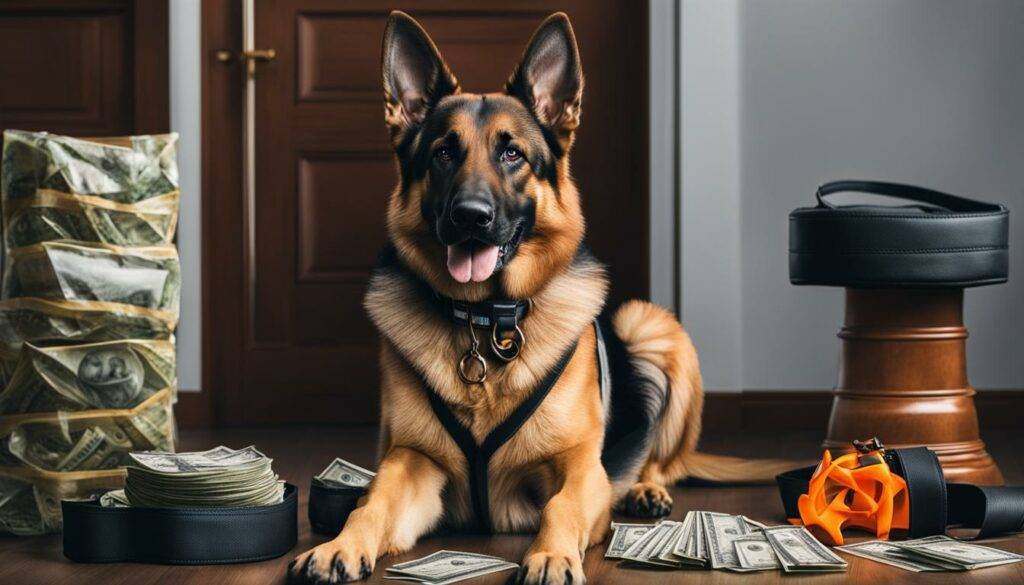
| Training Program | Cost |
|---|---|
| Service Dog Training – Hourly Rate | $120 per hour |
| Package Deals (Multiple Sessions) | Discounted pricing may be available |
It’s important to inquire about any available discounts or package deals when discussing the cost of training a German Shepherd as a service dog. Some training programs may offer reduced rates for multiple sessions per month or special promotions, so be sure to ask about any potential cost-saving options.
Costs of Training Programs at Major Pet Retailers
When it comes to training your furry companion, major pet retailers such as Petsmart and Petco offer convenient options. Not only do they provide training programs, but they also have a wide range of pet supplies to meet your needs. Let’s take a closer look at the costs of dog training at these popular retailers:
Petsmart Dog Training Cost
Petsmart offers a 6-week training program known as their “Training Essentials” course. The cost for this program is $120. The classes are conducted in a group setting, allowing your dog to learn and socialize with other furry friends. Petsmart occasionally offers special discounts and promotions, so it’s worth keeping an eye out for those opportunities to save on your training investment.
Petco Dog Training Cost
At Petco, you’ll find a similar 6-week training program designed to help your dog develop essential obedience skills. The cost for this program is $109. Like Petsmart, Petco also offers occasional promotions and discounts, so be sure to check for any ongoing deals. Both Petsmart and Petco provide group training classes which typically offer a more budget-friendly option compared to private training sessions.
| Retailer | Training Program | Duration | Cost |
|---|---|---|---|
| Petsmart | Training Essentials | 6 weeks | $120 |
| Petco | 6-Week Training Program | 6 weeks | $109 |
Training your dog at these well-known pet retailers provides you with the convenience of accessible locations and trained professionals who can guide you and your dog on your training journey. The group setting also offers an opportunity for your dog to socialize and learn alongside other dogs, enhancing their overall training experience.
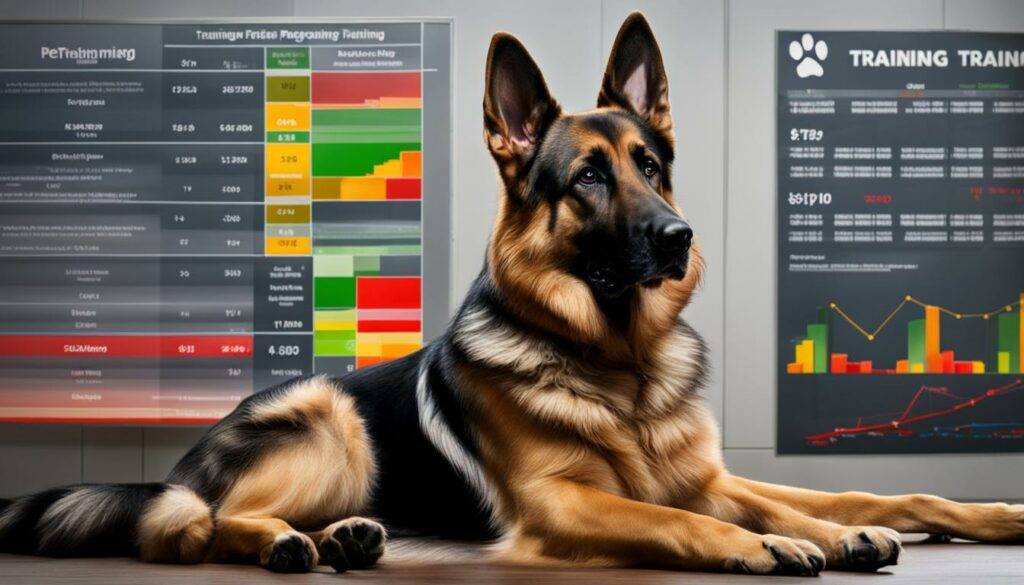
Remember, the cost of training is an investment in your dog’s well-being and obedience. Choose a program that aligns with your budget and training goals, ensuring you and your furry friend can enjoy a happy and harmonious life together.
Conclusion
In conclusion, training a German Shepherd is a vital investment in their well-being and obedience. The cost of training can vary based on factors like the type of training, trainer quality, and training school location. Options include group classes, private sessions, boot camps, and online programs. It’s important to select a training program that fits your budget and aligns with your goals.
Remember to consider ongoing expenses like high-quality food, grooming, and additional training when owning a German Shepherd. Training is not just about cost; it’s a commitment to their physical and mental health. The benefits of a well-trained German Shepherd are priceless.
To summarize the German Shepherd training costs and tips, average prices range from $30 to $80 per basic obedience class, while private sessions can cost between $45 and $120 per class. Dog boot camps can range from $600 to $1,250 per week, while training a German Shepherd as a service dog costs around $120 per hour. You can also opt for training at home using online programs or following instructional videos.
When selecting a training program, factors such as trainer quality, training type, and location should be considered. Ultimately, finding the right balance between cost and effectiveness is crucial for providing your German Shepherd with the training they need to thrive.
FAQ
How much does it cost to train a German Shepherd?
The average price of German Shepherd training is $30 to $80 per basic obedience class. Dog obedience training schools cost $250 to $700 per week. The average cost to train a Shepherd as a service dog is $120 per hour.
What factors can affect the cost of German Shepherd training?
The cost of training a German Shepherd can be influenced by factors such as the quality of the trainer, one-to-one or group classes, and the location of the training school. Other factors to consider include training supplies, travel expenses, parking fees, and the time required for training sessions.
What types of training options are available for German Shepherds?
There are various training options available for German Shepherds, including group training classes, private training sessions, dog boot camps, and online training programs. Costs for these options can vary.
Can I train my German Shepherd at home?
Yes, you can train your German Shepherd at home using online training programs or instructional videos and step-by-step directions. Training at home can be a cost-effective option but requires dedication and consistency.
How much do German Shepherd training schools cost?
German Shepherd training schools can cost anywhere from $250 to $700 per week. Some schools may offer package pricing deals or discounts for longer programs.
How much does it cost to train a German Shepherd as a service dog?
Training a German Shepherd as a service dog for therapy, support, or protection functions can cost around $120 per hour. Some training schools may offer price discounts for multiple sessions per month.
What are the costs of training programs at major pet retailers?
Major retailers such as Petsmart and Petco offer dog training programs. Petsmart’s 6-week program costs $120, while Petco’s program costs $109. These programs are conducted in a store setting and focus on basic obedience training.
What should I consider when training a German Shepherd?
When training a German Shepherd, it’s important to consider the overall costs, ongoing expenses, and the commitment required for their physical and mental well-being. High-quality food, grooming, and continued training are additional costs to consider.
Source Links
Dog Care and Maintenance
Mastering How to Potty Train a Dog in 7 Days – Fast & Surefire Tips
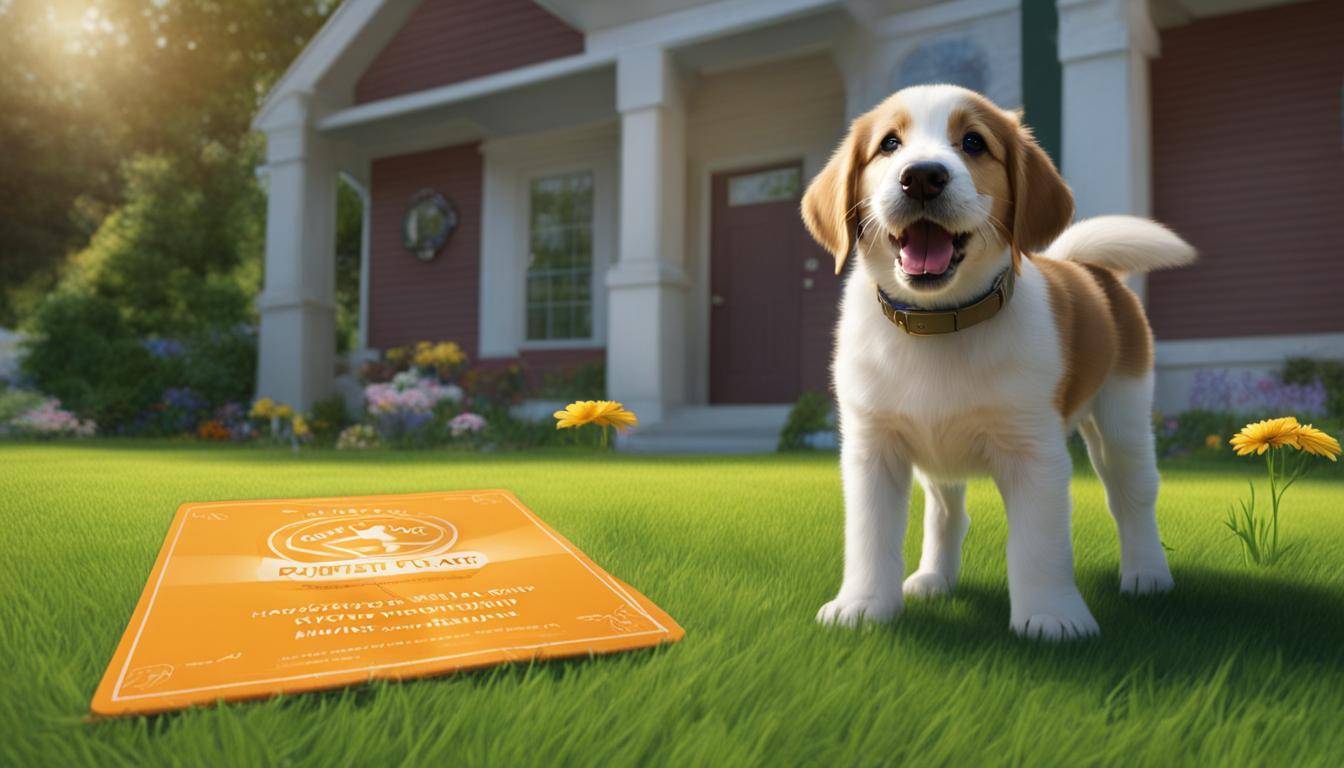
Learning how to potty train a puppy can be a challenge, but it is crucial for building a trusting and loving relationship with your new furry friend. Ignoring potty training can lead to issues down the line, so it’s essential to understand the fundamentals of training. In this article, we will provide you with fast and surefire tips to successfully potty train your dog in just 7 days.
Key Takeaways:
- Consistency and patience are key to successful potty training.
- Establish a routine by taking your puppy outside at specific times.
- Use positive reinforcement and rewards to encourage good behavior.
- Be prepared for accidents and clean them thoroughly to prevent repeat incidents.
- Crate training can be a helpful tool for potty training and providing a safe space for your puppy.
The Fundamentals of Potty Training a Puppy
Potty training a puppy is an essential part of the journey to a well-behaved and happy canine companion. It requires patience, consistency, and an understanding of your puppy’s needs. In this section, we will delve into the fundamentals of puppy potty training and provide you with valuable tips to set you and your furry friend up for success.
One of the key principles of potty training is setting the right routines. Start by selecting a reputable breeder who emphasizes good potty habits from an early age. This foundation will make the training process smoother. Remember that accidents may happen, so be prepared for them. Take your puppy outside to their designated potty area whenever they show signs of needing to go, such as sniffing or circling. Always praise and reward your puppy when they eliminate outside to reinforce the positive behavior.
In addition to consistent potty breaks, it’s important to keep a watchful eye on your puppy when indoors. Limit their freedom by confining them to a puppy-proofed area or using a crate. This will prevent accidents and help them learn to hold their bladder and bowels. Remember to provide plenty of opportunities for exercise and playtime outside of the confined space.
Creating a Puppy Potty Training Schedule
A puppy potty training schedule is a valuable tool in establishing routine and consistency. Take your puppy outside first thing in the morning, after every meal, nap, playtime, and before bedtime. Use the same exit door and designated potty area each time to reinforce the connection. During the initial stages of training, take your puppy out every hour or so to prevent accidents and provide them with an opportunity to eliminate outside.
| Time | Activity |
|---|---|
| 6:30 AM | Take puppy outside for potty break |
| 7:00 AM | Feed puppy breakfast |
| 7:15 AM | Take puppy outside for potty break |
| 8:00 AM | Playtime |
| 8:30 AM | Take puppy outside for potty break |
Remember to adjust the schedule based on your puppy’s age, breed, and individual needs. Consistency is key, so stick to the schedule as closely as possible. With time and patience, your puppy will learn to hold their bladder and bowels, leading to successful potty training.
Setting Your Puppy’s Routine
Establishing a routine is crucial for successful potty training. Consistency and timing play a significant role in helping your puppy understand when and where they should go potty. By following a consistent schedule, you can set your puppy up for success and make the training process more efficient.
Creating a Puppy Potty Training Schedule
A puppy potty training routine should include regular potty breaks throughout the day. Here is a sample schedule to help you get started:
| Time | Potty Break |
|---|---|
| 6:00 AM | Take your puppy outside for a potty break. |
| 7:30 AM | Another potty break after breakfast. |
| 10:00 AM | Potty break following a nap or playtime. |
| 12:00 PM | Potty break before lunch. |
| 3:00 PM | Potty break after another nap or playtime session. |
| 6:00 PM | Potty break before dinner. |
| 8:30 PM | Final potty break before bedtime. |
Remember that every puppy is different, and you may need to adjust the schedule based on your puppy’s individual needs. Be observant and watch for signs that your puppy needs to go, such as circling or sniffing the floor. Always reward your puppy with praise and treats when they go potty outside, reinforcing the positive behavior and encouraging them to continue.
Consistency in Training
Consistency plays a crucial role in dog training, and it is especially important when it comes to potty training. Being a consistent dog owner sets clear expectations for your furry friend and helps them understand the desired behaviors. Consistency means following the same routine, using the same commands, and providing the same positive reinforcement every time.
When it comes to potty training, consistency means taking your dog to the same area every time they need to go. This helps them associate that spot with the act of relieving themselves. Avoid distractions during potty breaks and give your dog ample time to do their business. Be patient and avoid rushing them. Remember, potty training takes time, and accidents may happen along the way.
In addition to consistency during potty training, it’s important to establish regular eating habits for your dog. Control their food and water intake and anticipate when they will need to go outside. This will help you avoid accidents and reinforce the potty training routine. Being consistent in all aspects of training will lead to better results and a stronger bond with your dog.
“Consistency is key when it comes to dog training. By being consistent in your commands, routines, and expectations, you provide clear guidance to your dog and promote positive behaviors.”
Training Tips for Dog Owners
Here are some additional training tips for dog owners to enhance consistency:
- Create a daily schedule and stick to it. Dogs thrive on routine, so having set times for meals, walks, and potty breaks will help them understand what is expected of them.
- Use positive reinforcement, such as treats, praise, and petting, to reward your dog for good behavior. This will motivate them to repeat the desired actions.
- Be patient and understanding. Dogs learn at their own pace, and it’s important to remain patient throughout the training process. Avoid punishment or negative reinforcement, as this can damage the trust between you and your dog.
- Consistency extends beyond training sessions. Ensure that all family members or caretakers are on the same page and follow the same training rules to avoid confusion and reinforce consistent behaviors.
By being consistent in your training methods and expectations, you will create a harmonious and well-behaved furry companion. Remember, training is an ongoing process, so continue to reinforce positive behaviors and address any challenges that may arise along the way.

Tips for Managing a Puppy in a Large House
If you have a spacious home, keeping an eye on your puppy can be a challenge. Here are some helpful tips to ensure your puppy’s safety and successful potty training:
Create a designated puppy area:
Set up a specific area in your home where your puppy can stay when you cannot directly supervise them. This area can be a room, a pen, or a gated-off section. Make sure it is safe and free from any potential hazards. Provide your puppy with toys, a comfortable bed, and access to food and water.
Use baby gates:
Install baby gates to block off certain areas of your home that you want to keep off-limits to your puppy. This will help prevent accidents and ensure that your puppy stays in a supervised area where you can easily keep an eye on them.
Establish a consistent routine:
Stick to a regular schedule for potty breaks, feeding times, and playtime. Consistency is key when it comes to potty training, and establishing a routine will help your puppy understand when and where they should go to relieve themselves.
By implementing these tips and creating an environment that promotes safety and consistency, you can effectively manage your puppy in a large house and support their potty training progress.
Dealing with Accidents and Setbacks
During the potty training process, accidents and setbacks are bound to happen. It’s important to stay patient and proactive in managing these situations to continue making progress with your dog’s potty training. Here are some helpful tips for handling accidents and overcoming challenges:
- Be prepared with cleaning supplies: Accidents are unavoidable, so it’s essential to have the right cleaning supplies on hand to promptly clean up any messes. Use an enzymatic cleaner specifically designed for pet accidents to effectively eliminate odors and prevent your dog from returning to the same spot. Thoroughly clean the area to minimize the chance of repeat accidents.
- Take your dog outside immediately after accidents: If you catch your dog in the act of having an accident indoors, calmly interrupt them and immediately take them outside. This helps reinforce the idea that going outside is the appropriate place to relieve themselves. Remember to praise and reward your dog when they go potty in the designated outdoor area.
- Stay consistent and maintain a routine: Consistency is key in overcoming setbacks. Stick to a regular potty training routine, taking your dog outside at the same times each day, especially after meals, naps, and play sessions. By maintaining a consistent schedule, your dog will learn to associate specific times with potty breaks, reducing the likelihood of accidents.
- Revisit basic training principles: If your dog continues to have accidents or encounters setbacks, it may be beneficial to revisit some basic training principles. Ensure you are providing clear and consistent commands, offering rewards for positive behavior, and reinforcing good habits. Remember to remain patient and avoid punishment, as it can hinder the training process.
By following these strategies and remaining dedicated to your dog’s potty training, you can overcome accidents and setbacks. Remember that each dog is unique, and the timeframe for successful potty training may vary. Stay positive, celebrate progress, and continue providing your furry friend with the guidance and support they need.

Table: Common Potty Training Challenges and Solutions
| Challenge | Solution |
|---|---|
| Accidents indoors | Clean accidents thoroughly and take the dog outside immediately after. |
| Marking territory | Neuter or spay your dog, provide plenty of exercise, and establish clear boundaries. |
| Anxiety or stress-related accidents | Address the underlying cause of anxiety and provide a calm and secure environment. |
| Resistance to going outside | Gradually introduce outdoor environments and make potty breaks a positive experience. |
Tips for Indoor Dogs or Time Alone
When it comes to indoor dogs or leaving your puppy alone for extended periods, potty training can present some unique challenges. However, with the right approach, you can successfully train your dog to use indoor potty pads. This section will provide you with valuable tips and strategies to make indoor dog potty training a breeze.
1. Gradual Transition: Start by placing the potty pads in a designated area indoors. Encourage your dog to use the pads by using verbal cues and rewards. As your dog becomes more comfortable using the pads, gradually move them closer to the door. The ultimate goal is to transition your dog from indoor to outdoor potty training, so eventually, the pads can be placed outside.
2. Consistency: Consistency is key when training your dog to use indoor potty pads. Establish a regular schedule for potty breaks and stick to it. Take your dog to the designated area at consistent intervals, such as after meals and naps. Praise and reward your dog whenever they successfully use the potty pads to reinforce the desired behavior.
3. Limit Freedom: When leaving your dog alone, it’s important to limit their freedom to avoid accidents. Create a confined space for your dog, such as a gated area or a playpen. Ensure that the area includes access to the designated potty area with the indoor potty pads. By limiting your dog’s freedom, you can prevent accidents and reinforce the importance of using the designated potty area.
| Indoor Dog Potty Training Tips | Training Dogs to Use Indoor Potty Pads |
|---|---|
| 1. Gradually transition from indoor to outdoor potty training by moving potty pads closer to the door. | 1. Use verbal cues and rewards to encourage dogs to use the indoor potty pads. |
| 2. Stick to a consistent potty training schedule to establish good habits. | 2. Establish a regular schedule for potty breaks and take dogs to the potty pads at consistent intervals. |
| 3. Limit your dog’s freedom by creating a confined space with access to the designated potty area. | 3. Confine dogs to a specific area with the indoor potty pads to reinforce the importance of using them. |
Crate Training and its Benefits
When it comes to potty training your dog, crate training can be a valuable tool in your arsenal. Crate training involves using a crate or kennel as a safe and secure space for your dog. Not only does crate training help with potty training, but it also promotes good behavior and provides your dog with a comfortable and familiar space of their own.
One of the key benefits of crate training is that it helps establish a routine for your dog. Dogs naturally avoid soiling their sleeping area, so by keeping your dog in a crate when you cannot supervise them, you’re teaching them to hold their bladder and bowels until it’s time to go outside.
Crate training also helps to prevent accidents in the house. When your dog is confined to a crate, they are less likely to have accidents or chew on furniture or other household items. It also gives you peace of mind knowing that your dog is safe and secure when you’re not able to watch them.
| Benefits of Crate Training | Explanation |
|---|---|
| Establishes a routine | Helps your dog learn to hold their bladder and bowels until it’s time to go outside |
| Prevents accidents | Keeps your dog from having accidents or chewing on furniture |
| Provides a safe space | Gives your dog a comfortable and familiar space of their own |
When crate training your dog, it’s important to introduce the crate gradually and make it a positive experience. Use treats, toys, and praise to help your dog associate the crate with positive feelings. Make sure the crate is the appropriate size for your dog, allowing them enough room to stand up, turn around, and lie down comfortably.
Remember, the crate should never be used as a form of punishment. It should be a place of refuge and relaxation for your dog. Be sure to give them plenty of opportunities for exercise and play outside the crate as well. With patience and consistency, crate training can be an effective tool in potty training your dog and providing them with a safe and comfortable space.
Puppy Potty Training FAQs
During the process of potty training your puppy, you may come across various questions and concerns. To help address these, we have compiled a list of frequently asked questions about puppy potty training. Take a look at the answers below to find solutions to common challenges:
How do I deal with accidents?
Accidents are a normal part of the potty training process. When accidents happen, it’s important to remain calm and avoid scolding or punishment, as this can create anxiety and hinder progress. Instead, clean up the accident using an enzymatic cleaner to remove any odors that may attract your puppy to the same spot again. Focus on reinforcing positive behavior by rewarding your puppy when they eliminate in the appropriate spot.
How do I transition from indoor to outdoor potty training?
If you’ve been using indoor potty pads or a designated area for your puppy, transitioning to outdoor potty training requires patience and consistency. Start by gradually moving the potty pads closer to the door leading outside. Once your puppy is comfortable with this change, move the pads just outside the door. Eventually, remove the pads completely and encourage your puppy to eliminate in the designated outdoor area. Be sure to offer praise and rewards when your puppy successfully goes outside.
Remember, consistency is key during the transition phase. Stick to a regular schedule, take your puppy outside frequently, and use positive reinforcement to reinforce good habits.
How can I establish a consistent routine?
Establishing a consistent routine is vital for successful potty training. Start by creating a schedule that includes regular potty breaks throughout the day, including first thing in the morning, after meals, after naps, and before bedtime. Take your puppy to the same designated spot each time and use specific cues or commands, such as “go potty.” Be patient and offer praise or rewards when your puppy eliminates in the right place. Consistency and positive reinforcement will help your puppy understand and follow the routine more effectively.
By addressing these common questions and concerns, you’ll be better equipped to navigate the challenges of puppy potty training. Remember, each puppy is unique, so it’s important to adapt your approach based on their individual needs and progress.

Conclusion
In conclusion, successfully potty training a dog in just 7 days requires consistency, patience, and a well-established routine. By following the tips and techniques outlined in this article, we can confidently say that you can achieve your potty training goals and enjoy a clean and happy home with your furry friend.
Remember that accidents are normal during the training process, and setbacks can happen. But don’t get discouraged! Focus on what’s working and build on your successes. Stay consistent in your training approach, use positive reinforcement, and maintain a watchful eye on your puppy.
With time and dedication, you’ll see progress and witness a stronger bond between you and your dog. So, wrap up your potty training journey with determination and a celebration of your wins. We believe in you and your four-legged companion – together, you can conquer potty training and create a loving and harmonious home environment.
FAQ
What should I do if my puppy has an accident indoors?
Accidents are normal during potty training. Clean the area thoroughly to remove odors that can attract your puppy back to the same spot. Stay calm and take your puppy outside immediately after any signs of needing to go.
How can I transition my puppy from indoor to outdoor potty training?
Gradually move indoor potty pads closer to the door and eventually outside. Use positive reinforcement to encourage your puppy to use the designated outdoor area for potty breaks.
Is crate training effective for potty training?
Yes, crate training can be an effective tool. Introduce the crate gradually using positive reinforcement. Use the crate when you cannot supervise your puppy or during sleep time, as dogs naturally avoid soiling their sleeping area.
How can I establish a consistent routine for potty training?
Set regular potty breaks first thing in the morning, after naps, playtime, and meals. Take your puppy outside every hour if none of these triggers occur. Use the same area, cues, and positive reinforcement consistently during the training process.
What should I do if I have a large home and can’t keep an eye on my puppy at all times?
Consider restricting your puppy’s access to a smaller area or using a crate for short periods when necessary. When taking your puppy outside, always use a leash and go to the same area. Avoid playing or talking to your puppy until they have finished their business.
How do I handle setbacks during potty training?
Stay positive and focus on what’s working. Clean accidents thoroughly and continue to reinforce potty training. Consistency and positive reinforcement will help your puppy overcome setbacks.
Can I potty train an indoor dog or a puppy left alone for extended periods?
Yes, you can use indoor potty pads or designated areas for your puppy to relieve themselves. Gradually transition from indoor to outdoor potty training by moving the pads closer to the door and eventually outside. Provide your puppy with access to their potty area when you need to leave them alone and limit their freedom to prevent accidents.
How do I use crate training for potty training?
Introduce the crate gradually and use positive reinforcement to make it a positive experience for your puppy. Use the crate when you cannot supervise them or during sleep time. Remember to never use the crate for punishment and give your puppy ample opportunities for exercise and play outside the crate.
What are some common questions about puppy potty training?
Common questions include how to deal with accidents, transitioning from indoor to outdoor training, crate training, and establishing a consistent routine. Refer to the FAQ section for more tips and answers to these questions.
Source Links
- https://www.everand.com/book/491221830/Puppy-Training-Guide-for-Beginners-How-to-Train-Your-Dog-or-Puppy-for-Kids-and-Adults-Following-a-Step-by-Step-Guide-Includes-Potty-Training-101-D
- https://kaufmannspuppytraining.com/en/how-to-potty-train-a-puppy-fast/
- https://es.everand.com/audiobook/476221819/Puppy-Training-Guide-for-Beginners
dogs
Mastering How to Train Older Dog to Use Indoor Potty
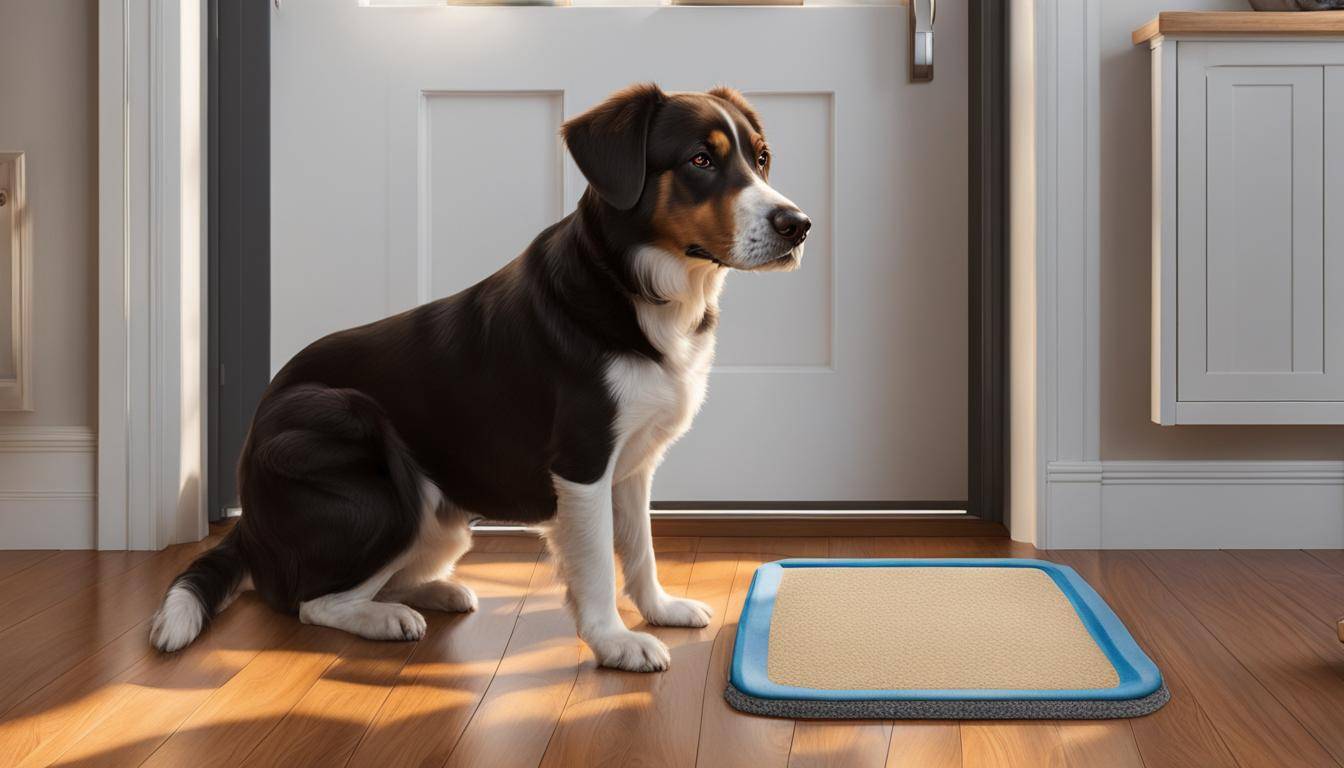
Welcome to our guide on how to train older dogs to use indoor potty! Potty training older dogs can be a challenge, but with the right techniques and consistency, it can be accomplished successfully. Whether you’re dealing with an older dog that has mobility issues or you simply prefer the convenience of indoor potty training, we’ve got you covered with tips and strategies to make the process easier.
Key Takeaways:
- Consistency is key when training older dogs to use indoor potty pads.
- Rewarding and reinforcing desired behavior can aid in the training process.
- Changing pads frequently and keeping them clean helps prevent accidents.
- Establishing a set potty routine and using verbal cues can help the dog develop a predictable bathroom routine.
- Consider using reusable pee pads for an eco-friendly option.
Benefits of Training an Older Dog to Use Indoor Potty
Training an older dog to use indoor potty can have several benefits. It provides relief from pain and discomfort, especially for dogs with mobility issues. These dogs may find it challenging to go outside to relieve themselves, but by using indoor potty pads, they can avoid unnecessary strain and discomfort. Additionally, training older dogs to use indoor potty allows them to stay indoors during extreme weather conditions, such as heavy rain or scorching heat. This not only keeps them safe but also ensures their comfort.
Older dogs can quickly learn to use indoor potty pads as part of their routine. The key is consistency and positive reinforcement. By using treats, toys, and verbal praise, you can encourage and motivate your older dog to use the designated indoor potty area. With consistent training methods, you can start seeing results in as little as a week. This not only helps the dog adapt to the new routine but also strengthens the bond between you and your furry friend.
Another benefit of training older dogs to use indoor potty is the option of using reusable pee pads. These eco-friendly pads not only reduce waste but also save you money in the long run. By investing in reusable pee pads, you can provide a comfortable and hygienic potty area for your older dog while minimizing environmental impact.
The Benefits of Training an Older Dog to Use Indoor Potty:
- Relieves pain and discomfort for dogs with mobility issues
- Allows dogs to avoid extreme weather conditions
- Quick learning with consistent training and positive reinforcement
- Strengthens the bond between you and your dog
- Environmentally-friendly option with reusable pee pads
In Conclusion
Training older dogs to use indoor potty provides numerous benefits. It improves their quality of life and allows them to comfortably relieve themselves indoors, especially if they have mobility issues or the weather is unfavorable. By implementing consistent training methods and positive reinforcement, you can successfully train your older dog to use indoor potty pads. Additionally, using reusable pee pads is a sustainable and cost-effective option. With patience and dedication, you can create a convenient potty routine for your older dog, making both of your lives easier.
The Importance of a Pee Pad Routine for Older Dogs
When it comes to teaching older dogs to use indoor potty, establishing a pee pad routine is of utmost importance. Having a consistent routine helps the dog understand where and when to go potty, making the training process easier and more effective. By designating a specific spot for the pee pads and using a consistent verbal cue, such as “go potty,” you can help your older dog associate the action with the command.
Creating a regular potty schedule is also crucial in developing a predictable bathroom routine for your older dog. This includes taking them to the designated potty area after waking up, after meals, and before bedtime. By following this routine, you can help your dog develop good habits and minimize the chances of accidents in the house.
In addition to establishing a pee pad routine, it is important to supervise your older dog closely during the potty training phase. This allows you to manage and prevent accidents, as well as reward and reinforce desired behavior. Positive reinforcement, such as treats and praise, can motivate your dog to use the pee pads consistently. With patience and consistency, your older dog will soon learn to use the indoor potty pads and maintain good potty habits.
| Benefits of a Pee Pad Routine for Older Dogs | Steps to Establishing a Pee Pad Routine |
|---|---|
|
|
“Establishing a pee pad routine is crucial when training older dogs to use indoor potty. By designating a specific spot and creating a regular potty schedule, you can help your older dog develop good bathroom habits. Supervising and managing accidents, as well as rewarding and reinforcing desired behavior, are essential aspects of the training process.”
Steps to Potty Train Older Dogs
Potty training older dogs can be achieved by following a few simple steps. Firstly, establishing a good foundation for obedience training is essential. Dogs of all ages, including older ones, benefit from understanding basic commands and behaviors. This foundation will make the potty training process smoother and more effective.
Using a crate can be a valuable tool for potty training as it provides a safe place for the dog to eliminate. Dogs naturally avoid soiling their sleeping area, so using a crate can help them develop control over their bladder and bowels. Gradually extending the duration the dog spends in the crate can help them adjust and avoid accidents.
Taking the dog outside for regular walks and potty breaks at specific times of the day is crucial for establishing the habit of using the toilet. Consistency is key here – always go to the same spot and use the same verbal cue to signal to the dog that it’s time to go potty. Rewarding the dog with treats and praise immediately after they eliminate in the designated area reinforces the desired behavior.
Table: Potty Training Schedule for Older Dogs
| Time of Day | Potty Break |
|---|---|
| Morning | Immediately after waking up |
| Afternoon | About 30 minutes after meals |
| Evening | Before bedtime |
Patience and consistency are key during the potty training process. It’s important to remember that accidents may happen, especially in the early stages of training. When accidents occur, it’s crucial not to punish the dog. Instead, calmly clean up the mess and continue with the training process. Punishment can create fear and confusion, making the training process more challenging.
By following these steps and remaining patient and consistent, older dogs can successfully be potty trained to use indoor facilities, providing convenience for them and their owners.
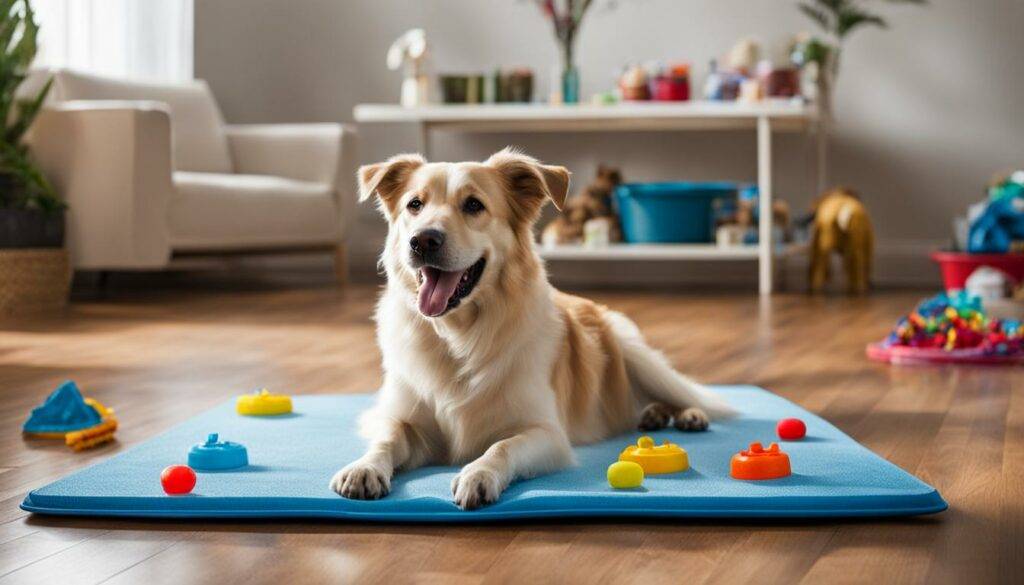
Tips for Successful Dog Potty Training
Potty training older dogs can be a challenging task, but with the right approach and techniques, it can be successful. Here are some tips to help you effectively potty train your furry friend:
1. Consistency is Key
Consistency is crucial when potty training older dogs. Establish a routine and stick to it. Take your dog to the designated potty area at regular intervals, such as after waking up, after meals, and before bedtime. This helps them develop a predictable bathroom routine and reduces the chances of accidents indoors.
2. Supervise and Manage Accidents
Closely supervise your dog during the potty training process to prevent accidents. Keep an eye on their behavior and body language, and if you see them showing signs of needing to go potty, quickly take them to the designated area. If accidents do happen, avoid punishment and instead redirect them to the correct spot. Clean indoor accidents thoroughly to remove any lingering odors that may attract the dog to that spot again.
3. Positive Reinforcement
Use positive reinforcement as a powerful tool in potty training older dogs. When your dog successfully goes potty in the designated area, immediately praise and reward them with treats, verbal praise, or affection. This helps reinforce the desired behavior and encourages them to continue using the designated spot. Positive reinforcement creates a positive learning environment and strengthens the bond between you and your furry companion.
| Benefits of Successful Potty Training | Tips for Successful Dog Potty Training |
|---|---|
| 1. Improved hygiene and cleanliness in the home | 1. Consistency is key |
| 2. Reduced risk of indoor accidents and messes | 2. Supervise and manage accidents |
| 3. Enhanced quality of life for your older dog | 3. Positive reinforcement |
| 4. Convenience and peace of mind for pet owners |
Can You Train an Older Dog to Use a Pee Pad?
Training an older dog to use a pee pad can be an effective solution for pet owners who are unable to take their dogs outside regularly or for dogs with certain health issues. Pee pads provide a convenient alternative to outdoor potty breaks and can be particularly helpful for dogs with limited mobility or incontinence problems. The training process involves introducing the dog to the pee pad and encouraging them to use it consistently.
One effective method is to place the pee pad in a designated area and allowing the dog to sniff and interact with it. Using positive reinforcement, such as treats and praise, can help motivate the dog to use the pad. Consistency is key during the training process, so it is important to take the dog to the pad regularly and reward them for using it. Creating a positive and comfortable environment around the pee pad can also encourage the dog to develop the habit of using it.
Training an older dog to use a pee pad requires patience and consistency. By providing a positive and encouraging environment and using positive reinforcement, such as treats and praise, pet owners can successfully train their dogs to use a pee pad as an alternative to going outside. Remember to be consistent in taking the dog to the pad and rewarding them for using it, and soon enough, they will develop the habit of using the pad consistently.
In conclusion, training an older dog to use a pee pad can be a practical solution for pet owners. With patience, consistency, and positive reinforcement, dogs can learn to use the pad reliably. However, it is important to note that some dogs may require more time and repetition to fully grasp the concept. Consulting with a professional dog trainer or veterinarian can provide additional guidance and support throughout the training process.
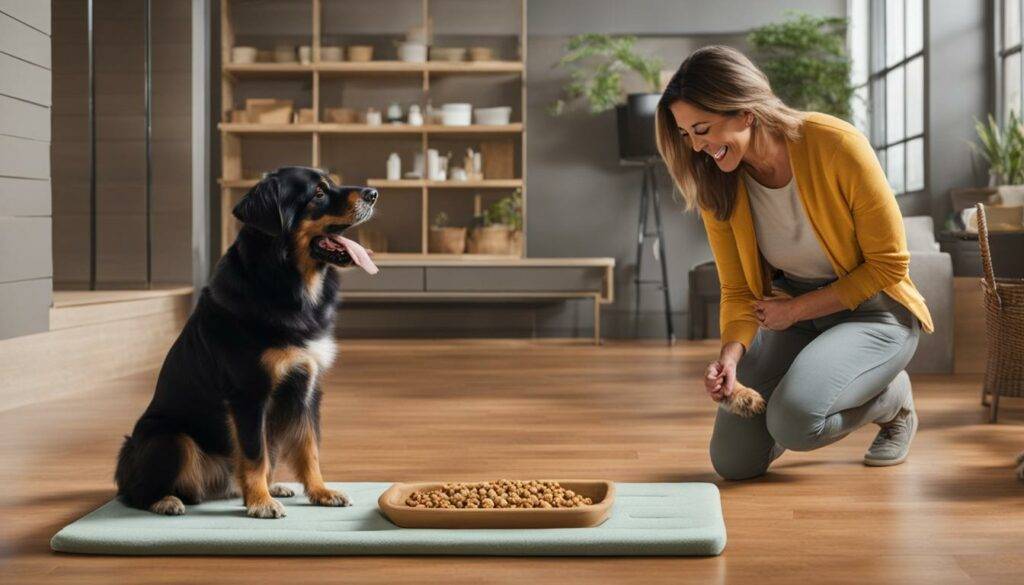
Table: Pros and Cons of Training an Older Dog to Use a Pee Pad
| Pros | Cons |
|---|---|
| Provides a convenient solution for pet owners with limited outdoor access | May take longer for some dogs to fully grasp the concept |
| Helps dogs with limited mobility or health issues | Requires consistent maintenance and cleaning of the pee pad |
| Can be a useful option during extreme weather conditions | May not be suitable for all dogs and living situations |
| Allows for greater control over accidents and indoor messes | May require additional training and reinforcement for some dogs |
Potty Training Tips for Dogs in Apartments
Living in an apartment with a dog poses unique challenges when it comes to potty training. Limited access to outdoor spaces means that indoor dog potty training becomes essential. Here are some tips to help you successfully potty train your older dog in an apartment.
Create a Designated Potty Area
Designate a specific area in your apartment for your dog’s potty needs. This could be a corner of a room or a bathroom with easy-to-clean floors. Use pee pads or a potty tray to create a defined spot for your dog to eliminate. Consistency is key, so make sure the designated area remains the same throughout the training process.
Establish a Potty Routine
Set a regular schedule for potty breaks and stick to it. Take your dog to the designated potty area first thing in the morning, after meals, and before bedtime. Use a verbal cue, such as “go potty,” to help your dog associate the command with the desired behavior. Reward your dog with treats and praise when they use the designated area, reinforcing the positive habit.
Troubleshooting Tips
If your dog is having difficulty with potty training, consider consulting a veterinarian to rule out any underlying medical conditions. Additionally, there are potty training aids available, such as attractant sprays or pheromone pads, that can help encourage your dog to use the designated area. Be patient and consistent in your training efforts, and remember to clean up accidents promptly to prevent lingering odors.
| Tip | Description |
|---|---|
| Stick to a Schedule | Establishing a consistent potty routine helps your dog develop a predictable bathroom routine. |
| Use Verbal Cues | Using a specific command, such as “go potty,” helps your dog understand what is expected of them. |
| Reward and Reinforce | Positive reinforcement, such as treats and praise, encourages your dog to use the designated potty area. |
| Consult a Veterinarian | If your dog is struggling with potty training, a veterinarian can help identify any underlying medical issues. |
| Use Potty Training Aids | Consider using attractant sprays or pheromone pads to help encourage your dog to use the designated area. |
| Be Patient and Consistent | Potty training takes time and patience. Stay consistent with your training efforts and remain positive. |

How to Train Your Dog to Use a Pee Pad
Teaching an older dog to use a pee pad indoors can be a straightforward process with the right approach. By following a few key steps, you can help your furry friend develop the habit of using the designated potty area.
Step 1: Introduce the Pee Pad
Start by placing the pee pad in a designated area that is easily accessible for your dog. Allow them to sniff and interact with the pad to familiarize themselves with it. This step helps create a positive association with the pad and encourages them to use it for elimination.
Step 2: Use Positive Reinforcement
Reward your dog with treats and praise every time they successfully use the pee pad. Positive reinforcement helps reinforce the desired behavior and encourages them to repeat it. Be consistent with rewards and provide them immediately after your dog uses the pad to reinforce the connection between the action and the reward.
Step 3: Leash Training
If your dog is having difficulty finding the pee pad, leash training can be helpful. Attach a leash to your dog’s collar and gently guide them towards the pad. Practice this routine multiple times a day until your dog becomes comfortable finding the pee pad on their own.
| Step | Description |
|---|---|
| Step 1 | Introduce the pee pad to your dog in a designated area. |
| Step 2 | Use positive reinforcement, such as treats and praise, to reward your dog for using the pee pad. |
| Step 3 | Leash train your dog to guide them towards the pee pad. |
Remember, consistency is key when training your dog to use a pee pad. Stick to a regular routine, provide positive reinforcement, and be patient throughout the process. By following these steps, you can successfully train your older dog to use an indoor pee pad.
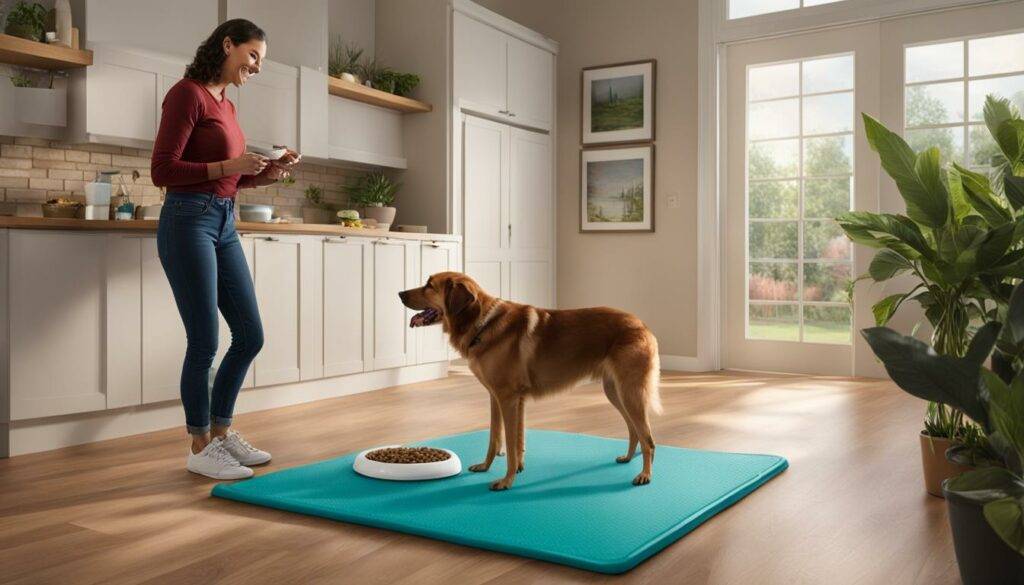
Training Techniques for Potty Training Older Dogs
When it comes to potty training older dogs, effective techniques and strategies can make all the difference. Here are some tips and tricks to help you successfully train your older dog to use indoor potty:
Consistency is Key
Consistency is crucial when training older dogs to use indoor potty. Establish a routine and stick to it, taking your dog to the designated potty area at regular intervals throughout the day. This helps them develop a predictable bathroom routine and reinforces the desired behavior. Consistent verbal cues and positive reinforcement, such as treats and praise, can also help solidify the habit.
Supervision and Management
Closely supervising your older dog during the training process is important to prevent accidents and reinforce the desired behavior. Keep an eye on your dog and redirect them to the designated potty area if you notice any signs that they need to go. Managing their access to different areas of the house can also help minimize accidents and keep the training consistent.
Thoroughly Clean Indoor Accidents
Accidents happen, especially during the early stages of potty training. When accidents occur indoors, it’s important to thoroughly clean the area to remove any lingering odors. Use enzymatic cleaners specifically designed for pet accidents, as these can effectively eliminate odors and discourage your dog from using the same spot again.
By implementing these effective techniques, you can successfully potty train your older dog to use indoor potty, ensuring a clean and comfortable environment for both you and your furry companion.
| Training Techniques for Potty Training Older Dogs | Benefits |
|---|---|
| Consistency | – Establish a routine and stick to it – Use consistent verbal cues and reinforcement |
| Supervision and Management | – Closely supervise your dog – Redirect them to the designated potty area – Manage access to different areas of the house |
| Thoroughly Clean Indoor Accidents | – Use enzymatic cleaners to remove odors – Discourage your dog from using the same spot again |
The Role of Consistency in Dog Potty Training
In the process of potty training older dogs, consistency plays a crucial role in achieving success. Consistency in establishing a routine and sticking to it helps the dog develop a predictable bathroom routine. By using consistent verbal cues and rewarding desired behavior, we reinforce the habit of using the designated potty area. It is important to be consistent in supervision and management to prevent accidents indoors.
Another aspect of consistency is in cleaning indoor accidents and removing lingering odors. Dogs have a keen sense of smell, and if they detect traces of previous accidents, it can lead to confusion and potential accidents in the same spot. Thoroughly cleaning indoor accidents with enzymatic cleaners helps eliminate odors and avoids any confusion for the dog.
Consistency goes hand in hand with patience in achieving successful potty training. It may take time for older dogs to fully grasp the concept and develop the desired habits. It is important to remain patient, avoid punishment for accidents, and instead focus on positive reinforcement when the dog successfully uses the designated potty area.
The Importance of Establishing a Routine
Establishing a routine is vital in potty training older dogs. Dogs thrive on predictability, and having a set schedule for potty breaks helps them develop a sense of when and where they should go. Designate specific times of the day for potty breaks, such as after waking up, after meals, and before bedtime.
“Consistency is key when it comes to potty training older dogs. By establishing a routine and sticking to it, we help our furry friends develop proper bathroom habits.”
Using consistent verbal cues, such as a specific command or phrase, also aids in the training process. Associating the command with the desired action helps the dog understand what is expected of them. With time and consistency, the dog will learn to respond to the verbal cue and use the designated potty area.
The Benefits of Consistency in Potty Training
Consistency in potty training provides several benefits for both the dog and their owner. When older dogs have a consistent routine, it reduces the likelihood of accidents indoors. They become accustomed to the designated potty area and understand that it is the appropriate place to go.
Consistency also helps build trust and strengthen the bond between the dog and their owner. By providing a consistent and positive learning environment, we foster a sense of security and confidence in our furry companions. This leads to better obedience and cooperation in all areas of training.
In conclusion, consistency is crucial in the potty training process for older dogs. By establishing a routine, using consistent verbal cues, and providing a positive environment, we can help our furry friends develop proper bathroom habits. Patience and understanding are key as older dogs may take time to adjust and fully grasp the concept. With consistency, we can achieve successful potty training that benefits both the dog and their owner.
The Importance of Positive Reinforcement in Dog Potty Training
Potty training older dogs requires patience, consistency, and a positive approach. Positive reinforcement plays a crucial role in this process, as it motivates dogs to engage in the desired behavior. By using rewards such as treats, verbal praise, and affection, we create a positive association with using the designated potty area. This not only helps them learn faster but also strengthens the bond between us and our furry friends.
Unlike punishment, which can create fear and confusion, positive reinforcement encourages dogs to continue engaging in the behavior we want to reinforce. When they go potty in the designated area, it is important to provide immediate rewards and praise to make a clear connection between their action and the positive outcome they receive.
“Positive reinforcement is a powerful tool in dog training. By focusing on rewarding desired behaviors, we can effectively teach dogs new habits and strengthen their trust and bond with us.”
Through positive reinforcement, we create a positive learning environment for our dogs. They become more motivated to learn and participate actively in the training process. By using positive reinforcement consistently, we can achieve successful potty training and help our older dogs maintain good bathroom habits.
The Benefits of Positive Reinforcement in Dog Potty Training
Positive reinforcement not only helps in potty training older dogs but also has a range of other benefits. It fosters a sense of trust and establishes a positive relationship between us and our dogs. It boosts their confidence and encourages them to engage in desired behaviors willingly. Positive reinforcement also reduces stress and anxiety, creating a calm and harmonious environment for our furry companions.
| Benefits of Positive Reinforcement in Potty Training Older Dogs |
|---|
| Builds trust and strengthens the bond with the dog |
| Boosts the dog’s confidence and encourages active participation |
| Reduces stress and anxiety |
| Creates a calm and harmonious environment |
Conclusion
Training older dogs to use indoor potty can be a rewarding and beneficial experience for both the dog and the owner. By following a few simple steps, such as establishing a routine and using positive reinforcement, you can successfully teach your dog to use the designated potty area.
Consistency is key in this process. By creating a structured environment and sticking to a regular schedule, you can help your dog develop a predictable bathroom routine. Additionally, supervising your dog closely and managing access to different areas of the house can prevent accidents and reinforce the desired behavior.
Remember to use positive reinforcement, such as treats and verbal praise, to reward your dog for using the indoor potty. Avoid punishment, as it can create fear and confusion. By creating a positive and consistent learning environment, you can effectively train your older dog to use indoor potty, providing convenience for both of you.
FAQ
Can an older dog be trained to use indoor potty pads?
Yes, older dogs can be trained to use indoor potty pads. Consistency is key when teaching them to use the pads as part of their toilet routine.
How can I train my older dog to use indoor potty pads?
You can train your older dog to use indoor potty pads by rewarding and reinforcing desired behavior with treats and toys. Changing the pads frequently and keeping them clean can also help prevent accidents.
Is it possible to potty train an older dog using a leash?
Yes, using a leash and taking the dog to the designated toilet area when needed can help establish the habit of using the indoor potty pad.
Are reusable pee pads a good option for potty training older dogs?
Yes, reusable pee pads are an eco-friendly option for potty training older dogs. They not only reduce environmental impact but also save money.
What are the benefits of potty training an older dog to use indoor potty?
Potty training an older dog to use indoor potty can provide relief from pain and discomfort, especially for dogs with mobility issues. It can also allow them to avoid going outside in extreme weather conditions.
How long does it take to potty train an older dog?
With positive reinforcement and consistent training methods, results can be seen in as little as a week.
What can I do to establish a pee pad routine for my older dog?
You can establish a pee pad routine by designating a specific spot for the pads, using a consistent verbal cue, and creating a regular potty schedule.
What are some important aspects of potty training older dogs?
Some important aspects of potty training older dogs include supervising and managing accidents, as well as rewarding and reinforcing desired behavior.
How can I train my older dog to use indoor potty in an apartment?
Training an older dog to use indoor potty in an apartment can be achieved by establishing a routine, using a crate or confinement area, and taking the dog outside regularly.
How do I train my dog to use a pee pad?
To train a dog to use a pee pad, you can place the pad in a designated area, allow the dog to interact with it, reward them for using the pad, and gradually lead them to it using a leash.
What techniques can be used for potty training older dogs?
Techniques such as providing a structured environment, using positive reinforcement, and consulting with professionals can be effective for potty training older dogs.
How important is consistency in dog potty training?
Consistency is crucial in dog potty training as it helps the dog develop a predictable bathroom routine and reinforces the desired behavior.
Why is positive reinforcement important in dog potty training?
Positive reinforcement creates a positive learning environment and motivates the dog to engage in the desired behavior, making the training process more effective.
Source Links
-

 cats7 months ago
cats7 months agoHow to Get Your Cats to Stop… Everything You Hate: Every No Needs a Yes!
-

 All Animals1 year ago
All Animals1 year agoALL about Lagomorphs Explained!
-

 All Animals11 months ago
All Animals11 months agoExplore the Wilderness: ALL about Carnivores Unleashed!
-

 Animals1 year ago
Animals1 year agoThe Wonders: ALL About Artiodactyls
-

 Cat Breeds6 months ago
Cat Breeds6 months agoWhat Are Some Rare Domestic Cat Breeds?
-

 Cat Breeds6 months ago
Cat Breeds6 months agoWhat Are the Top Family-Friendly Domestic Cat Breeds?
-

 Cat Breeds6 months ago
Cat Breeds6 months agoDiscover Rare Domestic Cat Breeds With Our Guide
-

 Cat Breeds6 months ago
Cat Breeds6 months agoTop Family-Friendly Domestic Cat Breeds

